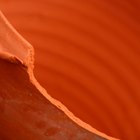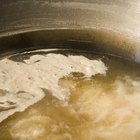
Geshas/iStock/GettyImages
It’s a matter of taste. Cooking with clay pots can intensify the flavor of your food and be an adventure to experiment with in the kitchen.
Curing and caring for clay pots is a fairly straightforward process. But without proper care, the pot can crack.
Benefits of Cooking with Clay Pots
Clay pots circulate steam throughout the cooking process. This ancient cookware creates moist meat dishes. Vegetables cooked alongside the cuts of meat will stay moist and tender without overcooking as the meat finishes.
Clay pots add a host of important nutrients to food, including magnesium, sulfur, iron, phosphorous and calcium. The slow cooking process allows the food inside the clay pot to retain all of its nutrients.
Clay is alkaline and neutralizes acid in the pH balance of food. This acts as a natural detox and makes the food prepared in the clay pot easier to digest. There are a wide range of clay pot recipes that are fairly simple to prepare, from chicken and rice to perfectly pillowy artisan bread.
Disadvantages of Cooking with Clay Pots
There are some disadvantages of cooking in clay pots. If the clay pot is not seasoned properly, then the pot has a high risk of cracking during cooking. Keeping an even temperature requires monitoring the heat source regularly.
To keep clay from cracking during cooking or seasoning, always put a clay pot in a cold oven so that it can adjust to the heat of the oven.
Seasoning Clay Pot
Soak the clay pot in water for 15 minutes or up to two hours to begin the seasoning process. After it is dry thoroughly, rub a clove of garlic all over the inside of the pot, then coat it with olive or vegetable oil.
Fill the ancient cookware almost full with water and put it in a cold oven for two to three hours. This can also be achieved on the stovetop.
Placing a clay pot on a hot burner can make it crack. A diffuser can help bring the clay pot up to the right temperature when seasoning it or using it to finish off dishes on the stovetop.
Caring for Clay Pots
A well-seasoned clay pot will last for decades when handled properly. Once the clay pot is seasoned well, it continues to need special care to keep that layer of seasoning in good condition. There are a few things to know before attempting to clean, cook or store the clay pot.
First, before cooking with the clay pot, submerge both the lid and base in cold water. A clay pot can’t be cleaned with dish soap or other random household stringer, no matter how mild you may think it is. The soap will settle into the pores of the clay and leach into the food. Simply use scalding hot water and a clean, damp sponge to remove any food from the surface of the clay pot. Drying the clay pot in sunlight can help sanitize it naturally.
A paste of equal parts baking soda and water rubbed in to the pot and left for 30 minutes before rinsing can clean an old, dirty pot without ruining the hard-earned layer of seasoning. But make sure it is completely dry before you put it away so that moisture doesn’t collect and cause bacteria to thrive or the pot’s sound structure to be compromised.
Place a paper towel on the lid and invert it into the base of the clay pot. Store the entire pot with the lid inverted and nestled into the bottom of the pot in a dark, dry cupboard until ready to use.
Related Articles

How to Use Terra-cotta Cookware

How To Clean Romertopf

Clay Roasters for Cooking

Cooking a Pot Roast in a Clay Pot

Directions for Cooking With Stoneware

Does Peroxide & Baking Soda Harm Cast ...
Can You Oven Cook With Pottery?

How to Cook With a Gas Fireplace

How to Use Pam to Season Cast Iron ...

How to Make a Baking Stone

What "Tools of the Trade" Cookware is ...

Instructions for an Emeril Cast-Iron ...

How to Refinish Cast Iron Cornstick Pans

How To Remove Fish Odor From a Cast ...

How to Clean an Oven Liner

How to Bake Bread in a Clay Pot

How to Reheat Leftover Pork Chops ...

How to Season Granite Grill Cooking ...
Brazilian Pepper Wood for Cooking

How to Clean a Pizza Stone
References
Writer Bio
Kimberley McGee has written for national and regional publications, including People magazine, the New York Times, Los Angeles Times, Las Vegas Review-Journal and more. The award-winning journalist has covered home decor, celebrity renovations, and sat down with reality HGTV stars to discuss the latest trends.